When an automotive startup sets out to disrupt the traditional car auction industry, the technical challenges are immense. This project required building a complete real-time auction platform capable of accepting simultaneous bids from hundreds of users across multiple locations - both online bidders from anywhere in the world and on-site participants at the physical auction venue. The system had to process bids in under 100ms while maintaining absolute accuracy in a highly competitive bidding environment where milliseconds matter.

I led a technical team of 4 developers in designing and implementing this sophisticated live auction management system that seamlessly integrated physical and digital bidding experiences. The platform combined real-time websocket communications, responsive multi-device interfaces, and a fully decoupled REST API architecture to create a comprehensive solution for the modern automotive auction business.
The Technical Challenge: Real-Time at Scale
Building an auction platform presents unique technical challenges that go far beyond typical web applications. In a live auction environment, every bid must be processed instantly, conflicts must be resolved automatically, and all participants must see updates in real-time without any perceptible delay.
Critical Requirements:
- Real-time bid processing - Accept bids from multiple sources simultaneously (online web interface, mobile apps, on-site terminals).
- Sub-100ms response times - From the moment a user clicks “Bid Now” until all participants see the updated price.
- Conflict resolution - Handle simultaneous bids from hundreds of users and determine the winning bid instantly.
- Zero data loss - Every bid must be recorded and processed, even during peak load.
- Multi-device responsiveness - Flawless operation on desktops, tablets, smartphones, and large venue displays.
- On-site and online integration - Seamless coordination between physical auction attendees and remote online bidders.
The Traditional Auction Problem:
Existing car auction platforms at the time (BCA, Autorola, Manheim, EurocarBid) had significant limitations. Most relied on periodic polling, which introduced delays and created a disjointed user experience. Server-side rendering made interfaces feel sluggish, and the tight coupling between frontend and backend made it difficult to support multiple client applications.
Our Solution: WebSocket-Based Real-Time Engine
The architecture centered on a high-performance websocket server built with ReactPHP that maintained persistent connections with all active clients. This eliminated the need for polling and enabled true push-based updates. Combined with an AngularJS single-page application frontend and a fully decoupled REST API backend, the system achieved exceptional performance while remaining maintainable and scalable.
System Architecture
The platform was built on a multi-tier architecture with clear separation between presentation, business logic, and data layers. This design allowed multiple applications to share the same data infrastructure while maintaining independent frontends.
Architecture Overview:
Key Architectural Decisions:
- WebSocket Server - Dedicated ReactPHP server for real-time bidding with optimized network stack.
- REST API - Symfony-based API for all non-real-time operations (vehicle management, user accounts, auction setup).
- Decoupled Frontend - AngularJS SPA consuming both REST API and WebSocket services.
- Queueing System - Sophisticated bid queue to handle conflicts and maintain order fairness.
- AWS Infrastructure - EC2 instances in eu-west-1 (Ireland) with plans to deploy bid servers closer to users for reduced latency.
Technology Stack
| Component | Technology | Purpose |
|---|---|---|
| Bid Server | ReactPHP + WebSockets | Real-time bid processing and distribution |
| REST API | Symfony 2.6 + FOSRestBundle | Business logic and data management |
| Frontend Framework | AngularJS 1.3 + Restangular | Reactive single-page application |
| UI Framework | Bootstrap + jQuery | Responsive design across all devices |
| Database | MySQL 5.6 | Persistent data storage |
| Infrastructure | AWS EC2 (Linux Ubuntu 14.04) | Scalable cloud hosting |
Real-Time Bidding Engine
The heart of the platform was the websocket-based bidding engine that achieved the critical sub-100ms response time requirement.
Performance Optimizations:
- Persistent WebSocket connections - No connection overhead on each interaction.
- Optimized network stack - Tuned Linux kernel parameters for maximum throughput.
- In-memory bid queue - Lightning-fast processing of incoming bids.
- Database query optimization - Minimized database round-trips during active bidding.
- Efficient serialization - Compact JSON messages for minimal bandwidth usage.
Achieved Response Times:
- Initial bid acceptance: <80ms (from button click to server acknowledgment).
- Bid distribution: <20ms (from server to all connected clients).
- Total end-to-end latency: <100ms (user click to price update on all screens).
These times were achieved with the server in Ireland and clients in Spain, adding 50-60ms of unnecessary network latency. The production deployment plan included placing bid servers in Madrid to achieve the target 30ms end-to-end response time.
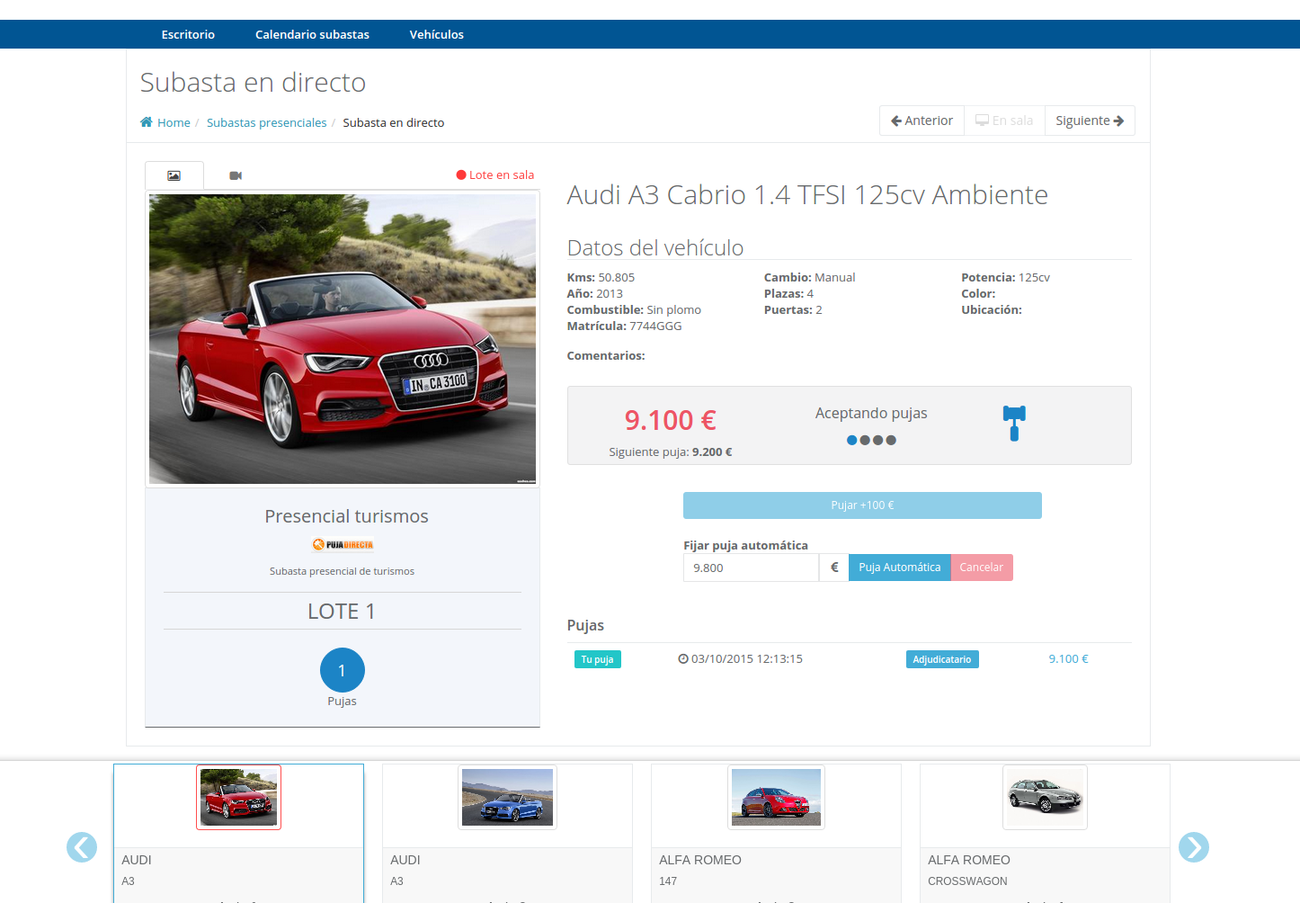
Online bidder interface with live auction feed, vehicle details, and instant bidding controls
Core Platform Features
1. Auctioneer and Scorer Control Panels
The on-site auction team required specialized interfaces optimized for rapid operation during live events. These panels were designed for large touchscreen displays and tablet devices.
Auctioneer Interface:
- Real-time bid tracking with automatic price updates.
- One-click vehicle progression through auction lot.
- Instant bid acceptance/rejection controls.
- Visual alerts for online and on-site bids.
- Comprehensive vehicle information display.
Scorer Interface:
- Parallel tracking of all auction activity.
- Detailed bid logging and verification.
- Sale confirmation and documentation.
- Buyer information management.
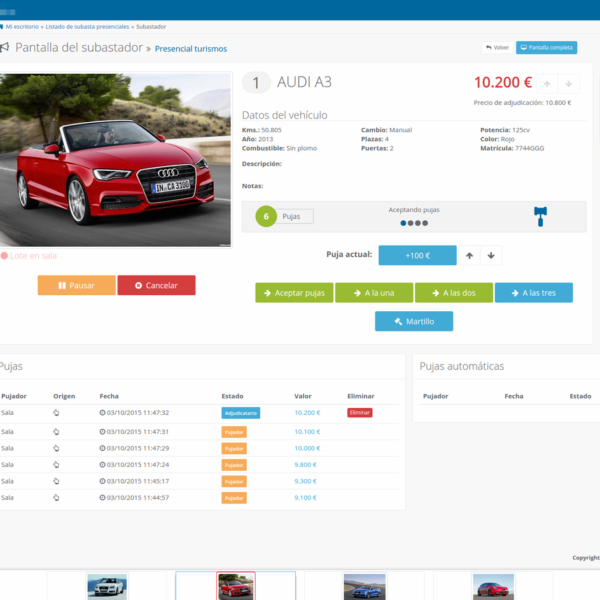
Auctioneer's primary interface showing vehicle details, current bid, and auction controls
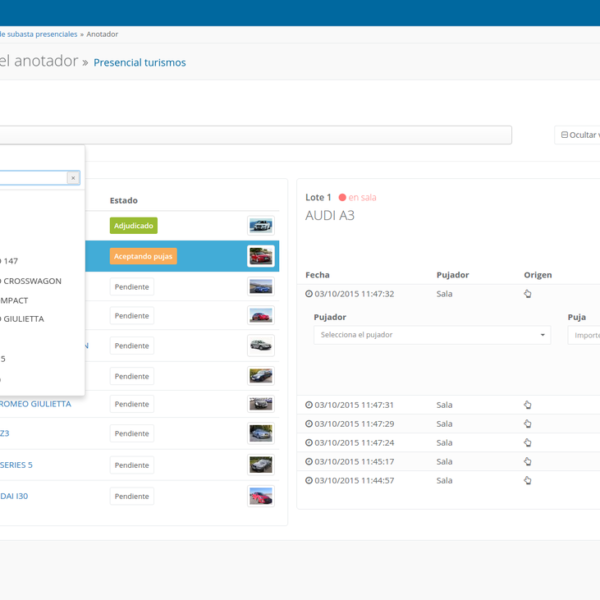
Scorer's interface for parallel auction tracking and sale documentation
2. Venue Display Screens
Large HD displays throughout the auction venue provided attendees with real-time information about ongoing auctions. These screens were optimized for visibility from a distance and updated instantly with every bid.
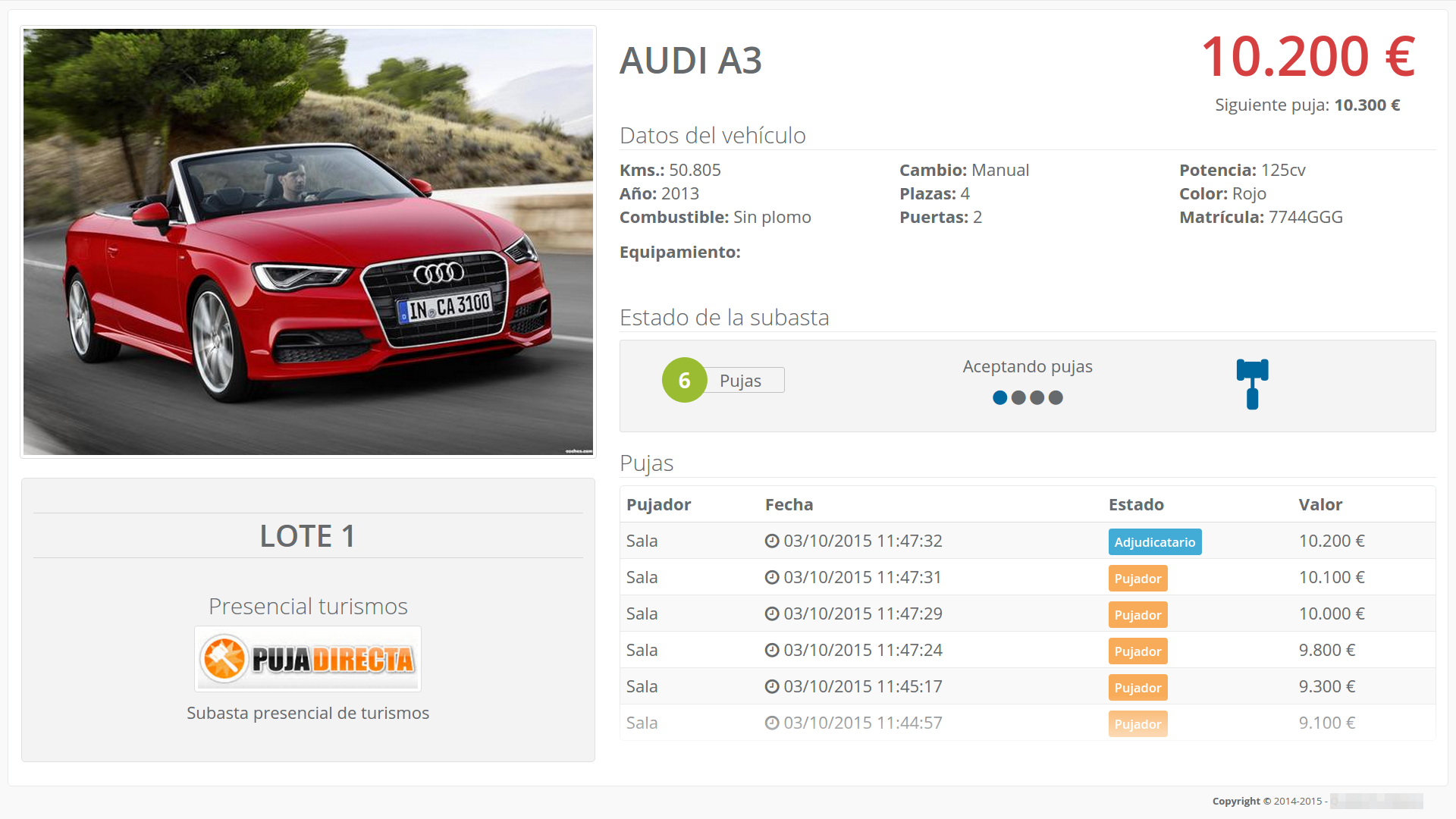
HD venue screen displaying current vehicle, pricing, and auction status in real-time
3. Comprehensive Administration Panel
Behind every successful auction is extensive preparation and management. The admin panel provided complete control over the entire auction lifecycle.
Administration Features:
- Vehicle Management - Complete vehicle database with detailed specifications, photos, condition reports.
- Auction Planning - Schedule management, lot ordering, reserve price configuration.
- User Account Management - Buyer/seller registration, credit verification, bidding authorization.
- Sales Processing - Post-auction sale finalization, documentation, payment tracking.
- Reporting and Analytics - Real-time auction performance, historical data, revenue tracking.

Admin dashboard providing overview of upcoming auctions and recent activity

Comprehensive vehicle listing with advanced filtering and bulk operations

Complete vehicle data entry form with specifications, pricing, and media management
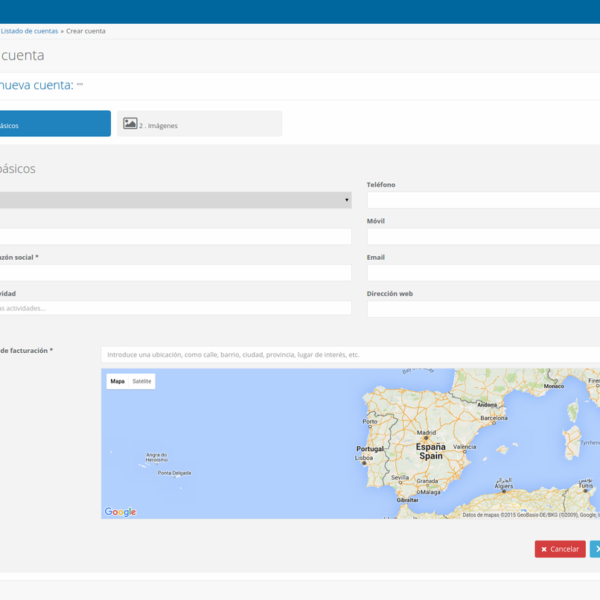
Buyer/seller registration form with credit verification integration
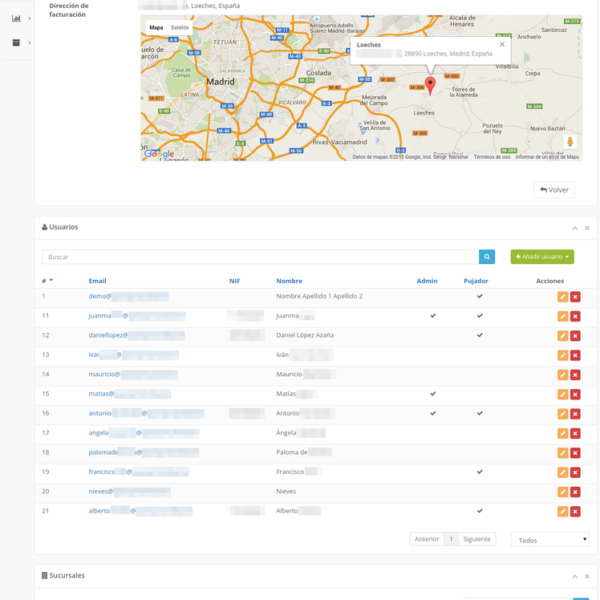
Responsive account detail view optimized for tablet use during events
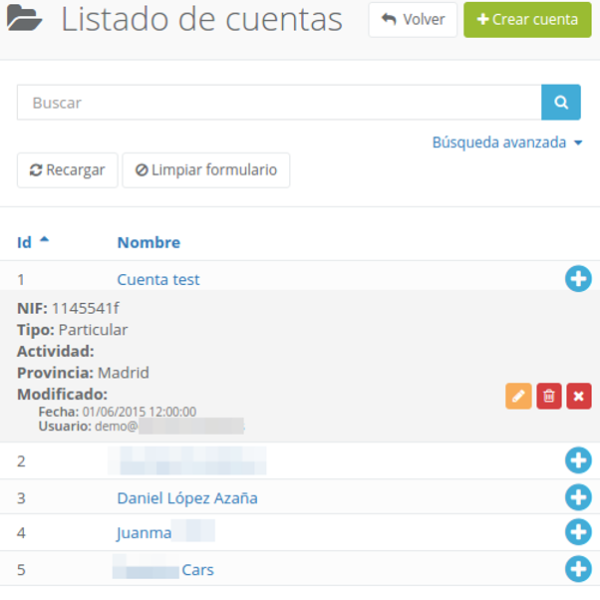
Mobile-optimized account listing for on-the-go access
4. Public Website and Online Bidding
External bidders needed a complete platform to participate in auctions remotely. The public website provided vehicle browsing, auction registration, and live bidding capabilities.
Public Website Features:
- Auction Calendar - Browse upcoming auctions and register interest.
- Vehicle Catalog - Detailed vehicle listings with photos, specifications, condition reports.
- Watchlist - Save favorite vehicles and receive notifications.
- Live Bidding - Real-time participation in active auctions.
- Bid History - Track personal bidding activity.
- Purchase Process - Complete sale finalization after winning bids.
- User Account - Manage profile, payment methods, purchase history.
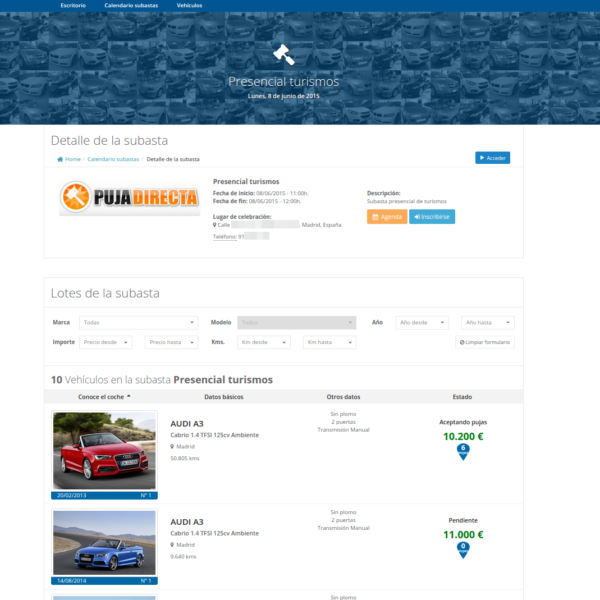
Detailed auction view showing vehicle specs, current bid, and auction timing

Interactive auction calendar for browsing and registering for upcoming events
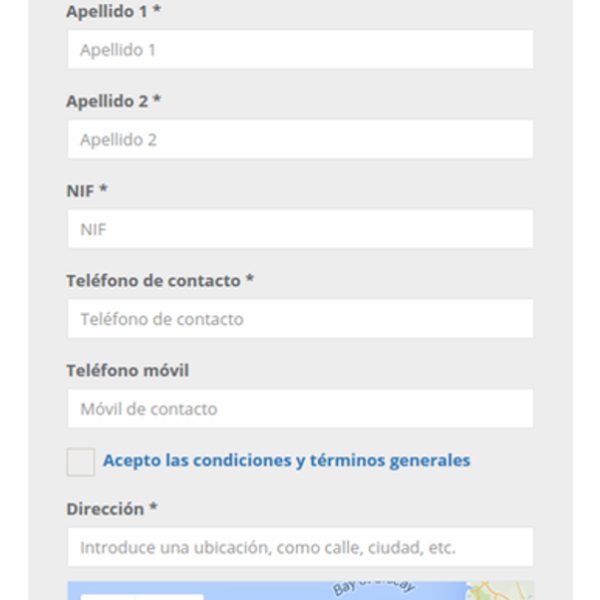
Mobile-optimized registration form for new bidders
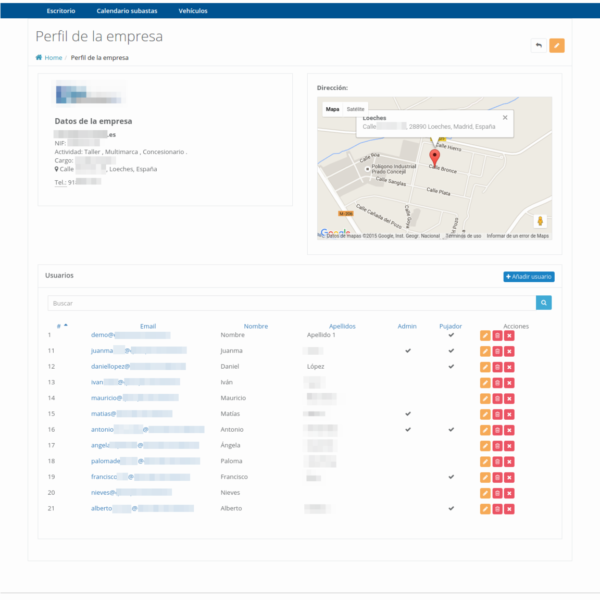
Bidder dashboard showing active bids, watchlist, and account settings

Comprehensive registration form with identity verification requirements
5. Fully Responsive Design
From the outset, responsive design was non-negotiable. The platform had to work flawlessly across an enormous range of devices and screen sizes.
Responsive Design Achievements:
- Mobile-first approach - Core functionality accessible on smartphones.
- Tablet optimization - Perfect for on-site staff using iPads during events.
- Desktop power user interfaces - Dense information displays for admin users.
- Large venue displays - 1920x1080 HD screens for audience visibility.
- Touch-optimized controls - Large, accessible buttons for touchscreen devices.
The entire frontend was built with Bootstrap framework, ensuring consistent behavior across all devices while maintaining a professional, modern appearance.
REST API Architecture
One of the most forward-thinking aspects of this project was the decision to build a completely decoupled REST API as the foundation of the system. This architectural choice provided enormous flexibility and future-proofing.
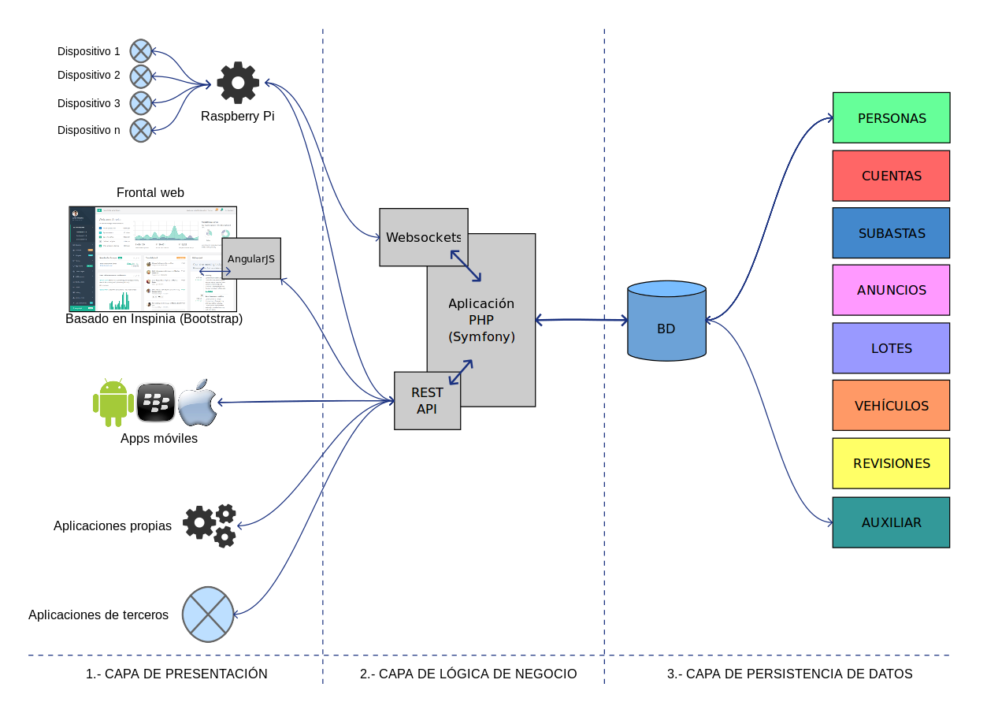
API Design Principles:
- Stateless design - Each request contains all necessary information.
- Resource-oriented endpoints - Clean, predictable URL structure.
- JSON responses - Lightweight, universally compatible data format.
- Authentication/Authorization - Token-based security for all protected endpoints.
- Versioning support - API version in URL for backward compatibility.
- Comprehensive documentation - Complete API reference for developers.
Benefits of the Decoupled API:
- Multiple frontends - Same API serving web, mobile, and internal applications.
- Third-party integration - Easy integration with CRM, valuation tools, and partner systems.
- Microservices ready - Clean interfaces between different system components.
- Independent scaling - Frontend and backend can scale separately based on load.
- Technology flexibility - Frontend can be rewritten without touching business logic.
This architectural decision was ahead of its time in 2016 and demonstrated sophisticated understanding of modern web application design patterns.
Conflict Resolution and Bid Queue System
One of the most technically challenging aspects was the bid conflict resolution system. When hundreds of users can submit bids simultaneously, the system must determine the winner instantly and fairly.
Bid Queue Implementation:
- Millisecond-precision timestamps - Every bid received a precise timestamp.
- Queue-based processing - Bids processed in strict chronological order.
- Optimistic locking - Prevent race conditions at database level.
- Instant feedback - Immediate confirmation or rejection to each bidder.
- Audit trail - Complete log of all bids for dispute resolution.
Fairness Guarantees:
- First bid to reach the server wins if submitted at the same price.
- Network latency compensated by timestamp at server reception.
- All rejected bids receive immediate notification with reason.
- Complete transparency in bid history for all participants.
Project Outcome and Lessons Learned
Despite the technical success of the platform, the startup unfortunately closed before launching operations due to commercial and management challenges. However, from a technical perspective, the project was fully completed and deployed, meeting all initial requirements and objectives.
Technical Achievements:
- Successful implementation of real-time websocket architecture.
- Sub-100ms bid processing achieved and validated.
- Comprehensive multi-device responsive design.
- Fully functional REST API with multiple clients.
- Robust conflict resolution and bid queue system.
- Complete admin, auctioneer, and public interfaces.
Key Learnings:
1. WebSocket Performance - The ReactPHP websocket server exceeded expectations. With proper optimization, websockets can handle hundreds of concurrent connections with minimal latency.
2. Decoupled Architecture Benefits - The REST API architecture proved its value even during development. Multiple teams could work on different frontends simultaneously without conflicts.
3. Real-Time Complexity - Building truly real-time systems requires attention to every layer of the stack. Network tuning, database optimization, and efficient serialization all contribute equally to final performance.
4. Responsive Design Trade-offs - Supporting such a wide range of devices required compromises. Some interfaces were optimized for specific use cases rather than trying to make every feature work identically everywhere.
5. Queue-Based Fairness - The bid queue system was essential for maintaining fairness. Simpler approaches would have resulted in inconsistent behavior under load.
Technical Inspiration and Competitive Analysis
The platform was inspired by leading car auction systems including BCA (British Car Auctions), Autorola, CarsOnTheWeb, Manheim, EurocarBid, Subastacar, and Subasto mi Coche. Through extensive competitive analysis, several areas for improvement were identified:
- Better real-time performance - Most competitors used polling, not websockets.
- Superior mobile experience - Many platforms had poor mobile interfaces.
- Cleaner API design - More modern REST conventions.
- Improved user experience - Simplified flows and better visual design.
The resulting platform successfully incorporated these improvements while maintaining feature parity with established competitors.
Conclusion
This car auction platform represented a comprehensive technical achievement in real-time web application development. The combination of websocket-based bidding, decoupled REST API architecture, and fully responsive multi-device design created a modern, scalable platform that was ready for production use.
While the business circumstances prevented the platform from serving real auctions, the technical lessons learned and architectural patterns developed continue to be valuable. The project demonstrated that with careful design and optimization, web applications can deliver the real-time performance required for time-critical business operations like live auctions.
The experience gained in building high-performance real-time systems, designing scalable APIs, and creating responsive multi-device interfaces has been invaluable in subsequent projects. This work laid the foundation for understanding how to build truly performant web applications that can compete with native software in demanding, mission-critical scenarios.

About the author
Daniel López Azaña
Tech entrepreneur and cloud architect with over 20 years of experience transforming infrastructures and automating processes.
Specialist in AI/LLM integration, Rust and Python development, and AWS & GCP architecture. Restless mind, idea generator, and passionate about technological innovation and AI.
Related projects

Trendmii Fashion Platform - Complete E-commerce Website with Custom CMS
Full-stack e-commerce fashion platform for Trendmii startup, built with Yii Framework featuring responsive design, custom blog system, comprehensive admin panel with Ace Admin theme, multilingual support for English and Spanish, social authentication integration, and online marketing consultancy. 6-month development delivering complete fashion marketplace solution.

SugarCRM Enterprise System for Electricity Distribution - Complete CRM with Custom Modules and Integrations
Comprehensive SugarCRM customization for Spanish electricity distribution company featuring 10+ custom modules for contracts, rates, consumption tracking, invoicing, tax reporting (Model 159), WordPress website integration for rate simulator and automated opportunity creation, Dropbox API integration for automated file processing, server deployment and hardening, backup policies, and scheduled email automation. 8-month ongoing development and maintenance delivering complete business management solution for energy sector.

Electricity Customer Portal - Private Web Application with Yii Framework and SugarCRM Integration
Secure customer portal for electricity distribution company built with Yii Framework, featuring SugarCRM database integration for real-time contract and billing data, Bootstrap responsive design, automated user registration with contract verification, role-based access control for customers and sales agents, and promotional code management. 5-month development delivering complete self-service customer platform.
Comments
Submit comment